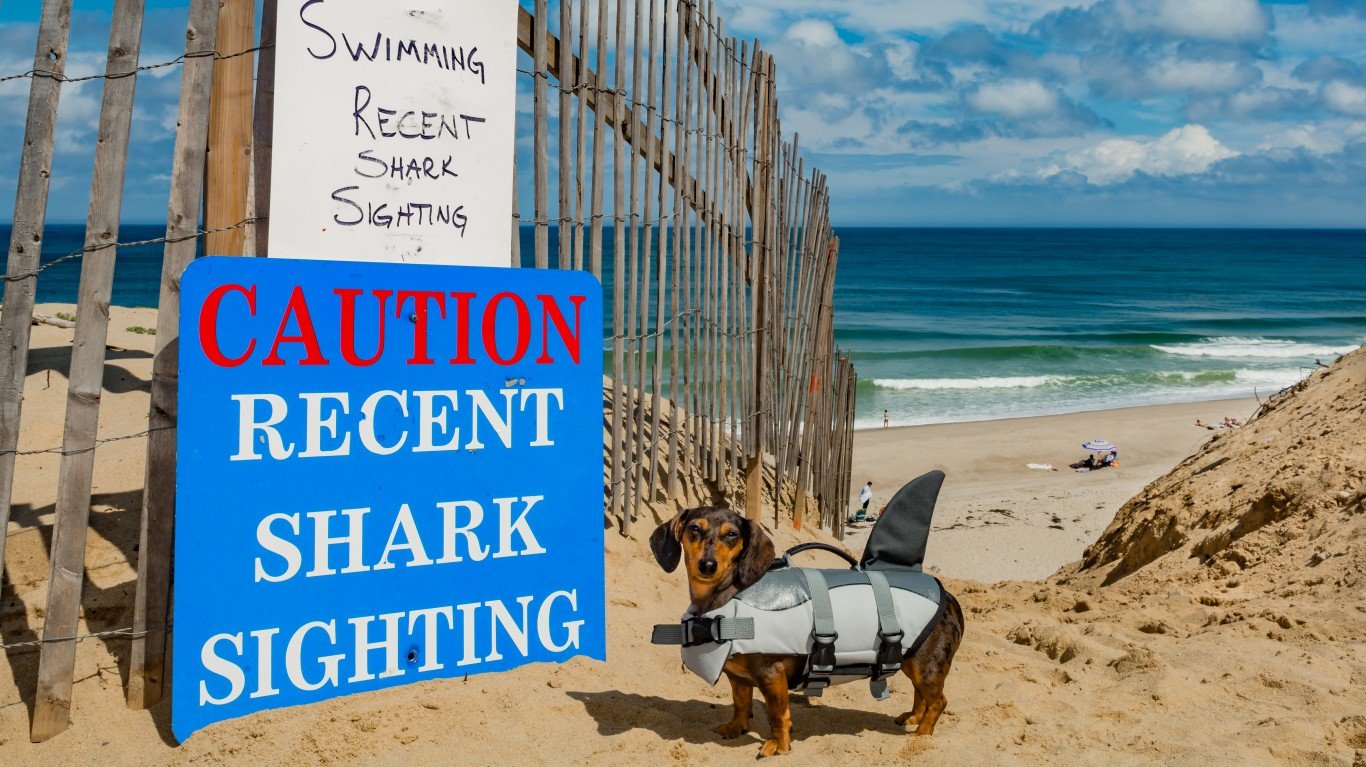

Dogs are the most popular pets in America. Almost 50 million households have at least one, according to the most recent data from the American Veterinary Medical Association. There are many reasons for this: dogs are excellent companions, they’re famously loyal, and there are numerous breeds to choose from. These range from toy dogs that could almost fit in your pocket to guard dogs that keep you safe at night. (If small ones are your preference, these are the tiniest dog breeds in the U.S.)
Every president in recent history except Donald Trump has had at least one dog. (Joe Biden moved his two German Shepherds, Champ and Major, into the White House in early January, but moved them out again in May after Major reportedly nipped a security agent. Champ died in June at the age of 13. These are 27 of the most famous presidential pets since the 1900s.
The extent of dog ownership varies from place to place. To compile a list of the states with the most dogs, 24/7 Tempo reviewed data from the Pet Ownership and Demographics Sourcebook, published in 2020 by the American Veterinary Medical Association for companion animal veterinarians and the animal health industry. Collected in 2017-2018, the data is the most recent available, reflecting the total number of households and the number and percentage of dog-owning households in the 48 contiguous states as of December 31, 2016.
Some trends are clear from the list: Dogs are particularly popular in the mountain, Midwest and Southern states. The top five dog-loving states are Idaho, Montana, Arkansas, Mississippi, and West Virginia — all fairly rural, low-density states where people live in single-family homes rather than apartments.
Click here to see the states with the most dogs.
Dogs seem to be less popular in the Northeast. The bottom six states on our list are New Hampshire, Connecticut, Rhode Island, New York, Vermont, and Massachusetts. That’s not to say that people don’t love dogs in the region. Almost a quarter of the households in New Hampshire and Connecticut have at least one canine resident, as do more than a quarter of the other four.
48. New Hampshire
> Households with at least one dog: 23.7%
> Number of dog-owning households: 119,000 — 8th lowest
> Number of human households: 502,000 — 8th lowest
> Dog population: 165,000 — 5th lowest
[in-text-ad]

47. Connecticut
> Households with at least one dog: 24.0%
> Number of dog-owning households: 344,000 — 20th lowest
> Number of human households: 1,430,000 — 20th lowest
> Dog population: 466,000 — 15th lowest

46. Rhode Island
> Households with at least one dog: 25.8%
> Number of dog-owning households: 116,000 — 7th lowest
> Number of human households: 450,000 — 7th lowest
> Dog population: 167,000 — 6th lowest

45. New York
> Households with at least one dog: 27.0%
> Number of dog-owning households: 2,116,000 — 4th highest
> Number of human households: 7,849,000 — 4th highest
> Dog population: 2,858,000 — 5th highest
[in-text-ad-2]

44. Vermont
> Households with at least one dog: 28.3%
> Number of dog-owning households: 75,000 — 2nd lowest
> Number of human households: 265,000 — 2nd lowest
> Dog population: 96,000 — 2nd lowest

43. Massachusetts
> Households with at least one dog: 28.9%
> Number of dog-owning households: 783,000 — 15th highest
> Number of human households: 2,714,000 — 15th highest
> Dog population: 1,096,000 — 22nd highest
[in-text-ad]

42. New Jersey
> Households with at least one dog: 29.1%
> Number of dog-owning households: 992,000 — 11th highest
> Number of human households: 3,414,000 — 11th highest
> Dog population: 1,253,000 — 17th highest

41. Maryland
> Households with at least one dog: 30.2%
> Number of dog-owning households: 683,000 — 20th highest
> Number of human households: 2,261,000 — 20th highest
> Dog population: 963,000 — 24th highest
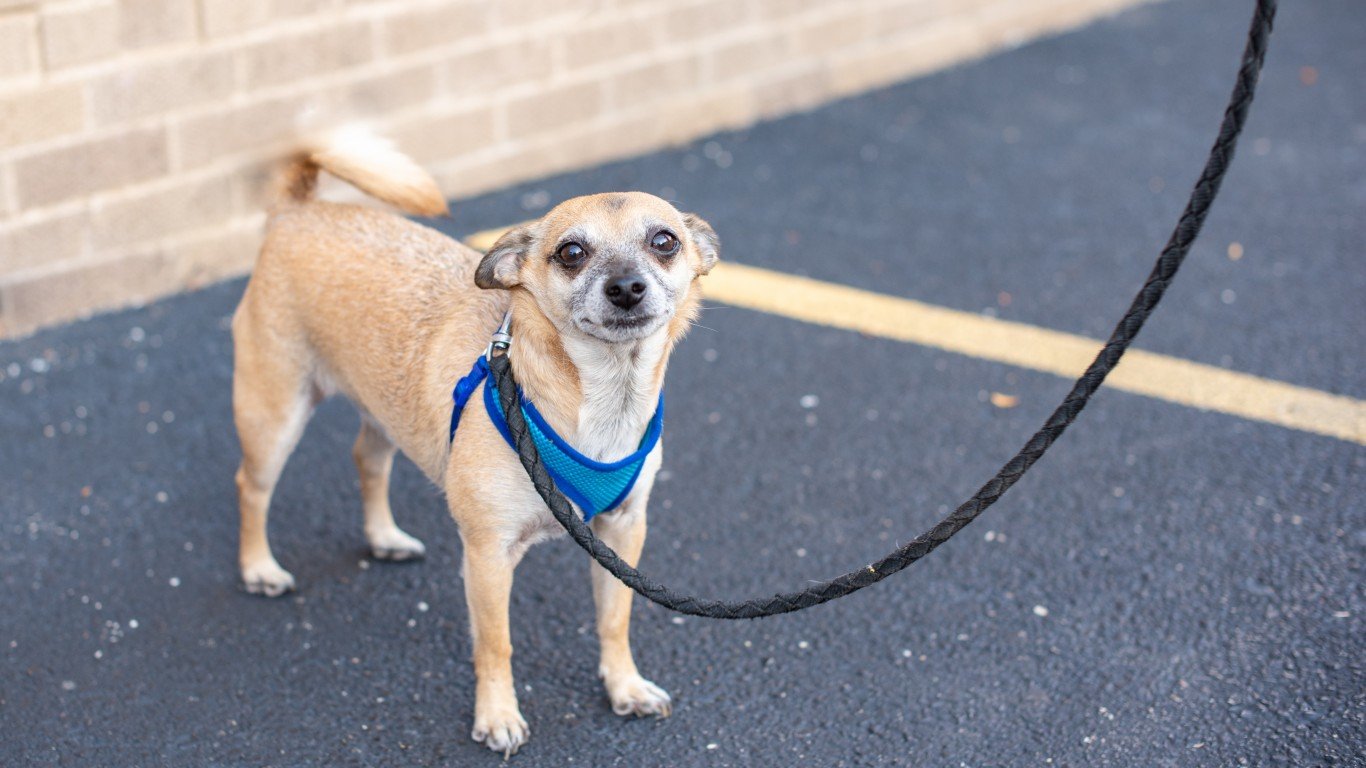
40. Illinois
> Households with at least one dog: 31.0%
> Number of dog-owning households: 1,590,000 — 5th highest
> Number of human households: 5,138,000 — 5th highest
> Dog population: 2,230,000 — 10th highest
[in-text-ad-2]
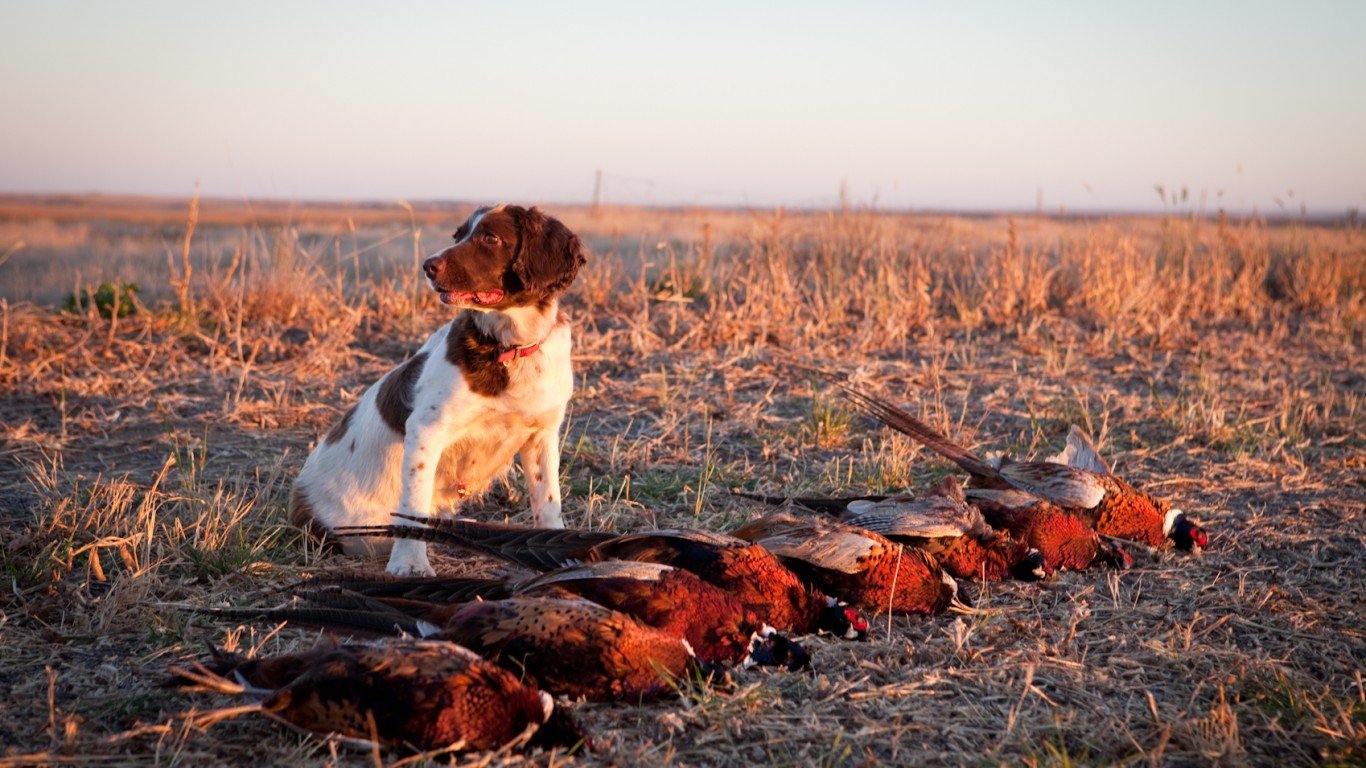
39. South Dakota
> Households with at least one dog: 32.1%
> Number of dog-owning households: 114,000 — 4th lowest
> Number of human households: 356,000 — 4th lowest
> Dog population: 149,000 — 4th lowest

38. Wisconsin
> Households with at least one dog: 33.6%
> Number of dog-owning households: 802,000 — 19th highest
> Number of human households: 2,389,000 — 19th highest
> Dog population: 1,141,000 — 18th highest
[in-text-ad]

37. Minnesota
> Households with at least one dog: 35.5%
> Number of dog-owning households: 793,000 — 21st highest
> Number of human households: 2,234,000 — 21st highest
> Dog population: 1,102,000 — 20th highest

36. Virginia
> Households with at least one dog: 35.6%
> Number of dog-owning households: 1,178,000 — 12th highest
> Number of human households: 3,306,000 — 12th highest
> Dog population: 1,946,000 — 12th highest

35. Maine
> Households with at least one dog: 35.9%
> Number of dog-owning households: 218,000 — 9th lowest
> Number of human households: 606,000 — 9th lowest
> Dog population: 324,000 — 12th lowest
[in-text-ad-2]
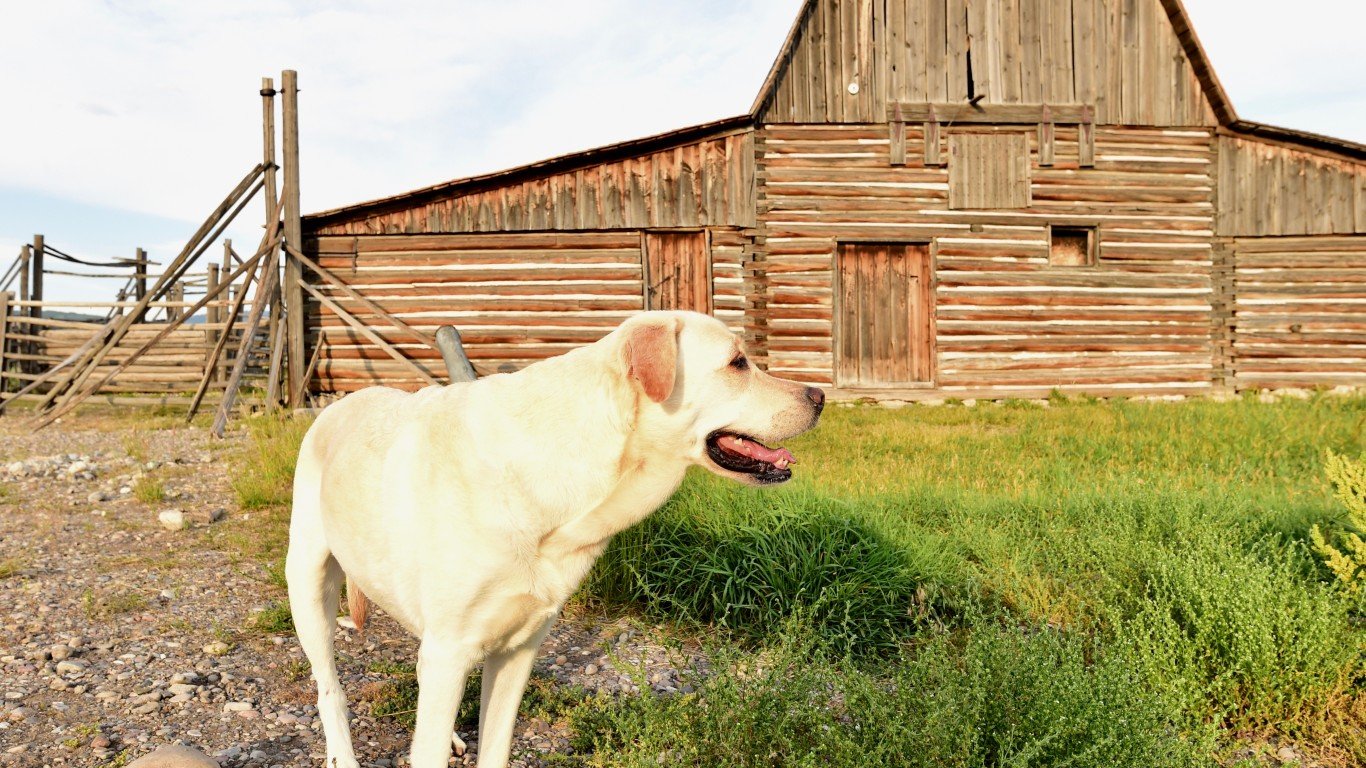
34. Wyoming
> Households with at least one dog: 36.0%
> Number of dog-owning households: 86,000 — the lowest
> Number of human households: 240,000 — the lowest
> Dog population: 65,000 — the lowest

33. Utah
> Households with at least one dog: 36.2%
> Number of dog-owning households: 367,000 — 14th lowest
> Number of human households: 1,014,000 — 14th lowest
> Dog population: 365,000 — 13th lowest
[in-text-ad]
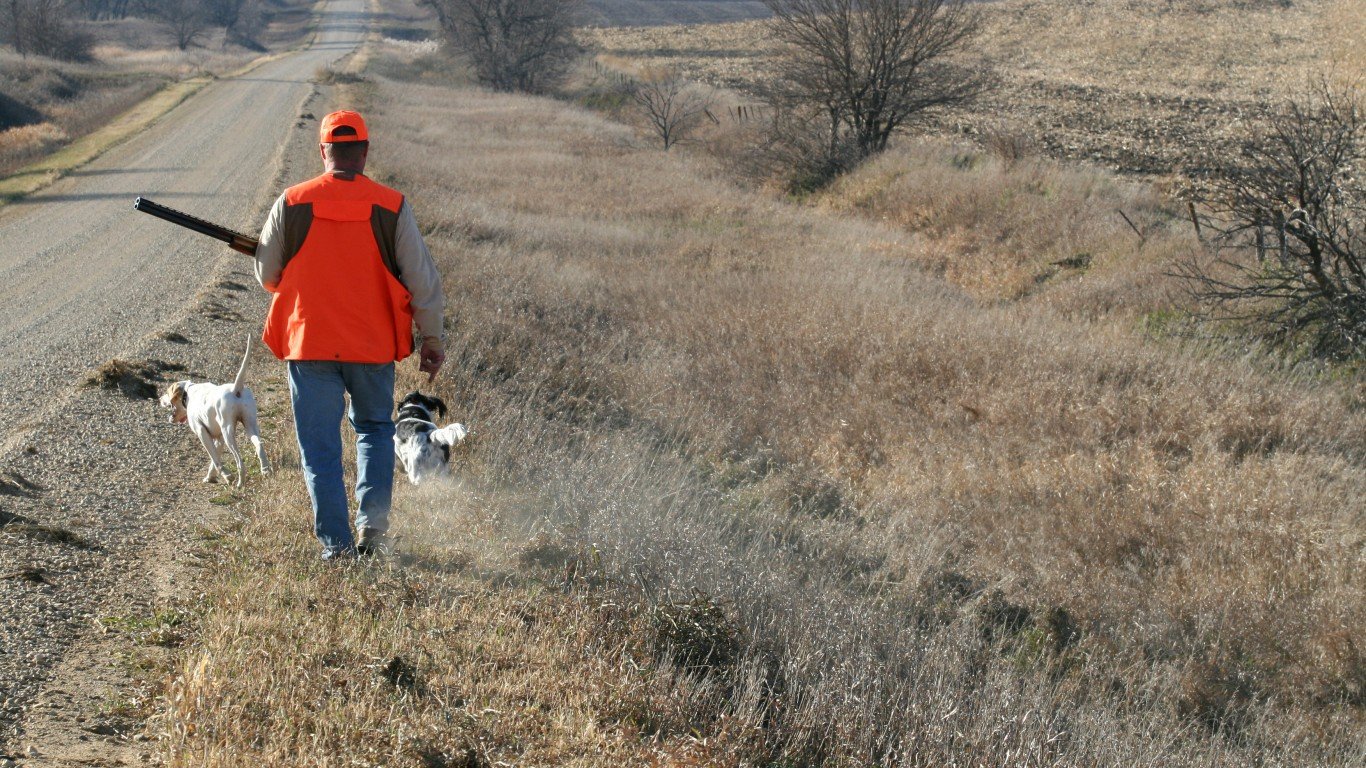
32. Iowa
> Households with at least one dog: 36.3%
> Number of dog-owning households: 472,000 — 19th lowest
> Number of human households: 1,298,000 — 19th lowest
> Dog population: 834,000 — 23rd lowest

31. Georgia
> Households with at least one dog: 36.7%
> Number of dog-owning households: 1,466,000 — 10th highest
> Number of human households: 3,999,000 — 10th highest
> Dog population: 2,573,000 — 9th highest

30. Nevada
> Households with at least one dog: 36.8%
> Number of dog-owning households: 412,000 — 15th lowest
> Number of human households: 1,122,000 — 15th lowest
> Dog population: 428,000 — 14th lowest
[in-text-ad-2]

29. Oregon
> Households with at least one dog: 37.8%
> Number of dog-owning households: 608,000 — 22nd lowest
> Number of human households: 1,606,000 — 22nd lowest
> Dog population: 997,000 — 23rd highest

28. Ohio
> Households with at least one dog: 37.9%
> Number of dog-owning households: 1,773,000 — 7th highest
> Number of human households: 4,682,000 — 7th highest
> Dog population: 2,973,000 — 4th highest
[in-text-ad]

27. Louisiana
> Households with at least one dog: 38.3%
> Number of dog-owning households: 707,000 — 23rd lowest
> Number of human households: 1,847,000 — 23rd lowest
> Dog population: 1,100,000 — 21st highest

26. Pennsylvania
> Households with at least one dog: 38.9%
> Number of dog-owning households: 1,990,000 — 6th highest
> Number of human households: 5,116,000 — 6th highest
> Dog population: 2,827,000 — 6th highest

25. New Mexico
> Households with at least one dog: 39.4%
> Number of dog-owning households: 314,000 — 13th lowest
> Number of human households: 796,000 — 13th lowest
> Dog population: 193,000 — 8th lowest
[in-text-ad-2]

24. Florida
> Households with at least one dog: 39.8%
> Number of dog-owning households: 3,285,000 — 3rd highest
> Number of human households: 8,260,000 — 3rd highest
> Dog population: 5,073,000 — 3rd highest

23. California
> Households with at least one dog: 40.1%
> Number of dog-owning households: 5,576,000 — the highest
> Number of human households: 13,911,000 — the highest
> Dog population: 8,690,000 — the highest
[in-text-ad]

22. North Carolina
> Households with at least one dog: 41.3%
> Number of dog-owning households: 1,663,000 — 9th highest
> Number of human households: 4,022,000 — 9th highest
> Dog population: 2,742,000 — 8th highest
21. Michigan
> Households with at least one dog: 41.9%
> Number of dog-owning households: 1,705,000 — 8th highest
> Number of human households: 4,071,000 — 8th highest
> Dog population: 2,763,000 — 7th highest

20. Delaware
> Households with at least one dog: 42.2%
> Number of dog-owning households: 168,000 — 5th lowest
> Number of human households: 399,000 — 5th lowest
> Dog population: 310,000 — 11th lowest
[in-text-ad-2]
19. Washington
> Households with at least one dog: 42.8%
> Number of dog-owning households: 1,217,000 — 13th highest
> Number of human households: 2,844,000 — 13th highest
> Dog population: 1,846,000 — 13th highest

18. Arizona
> Households with at least one dog: 43.0%
> Number of dog-owning households: 1,129,000 — 17th highest
> Number of human households: 2,624,000 — 17th highest
> Dog population: 907,000 — 24th lowest
[in-text-ad]
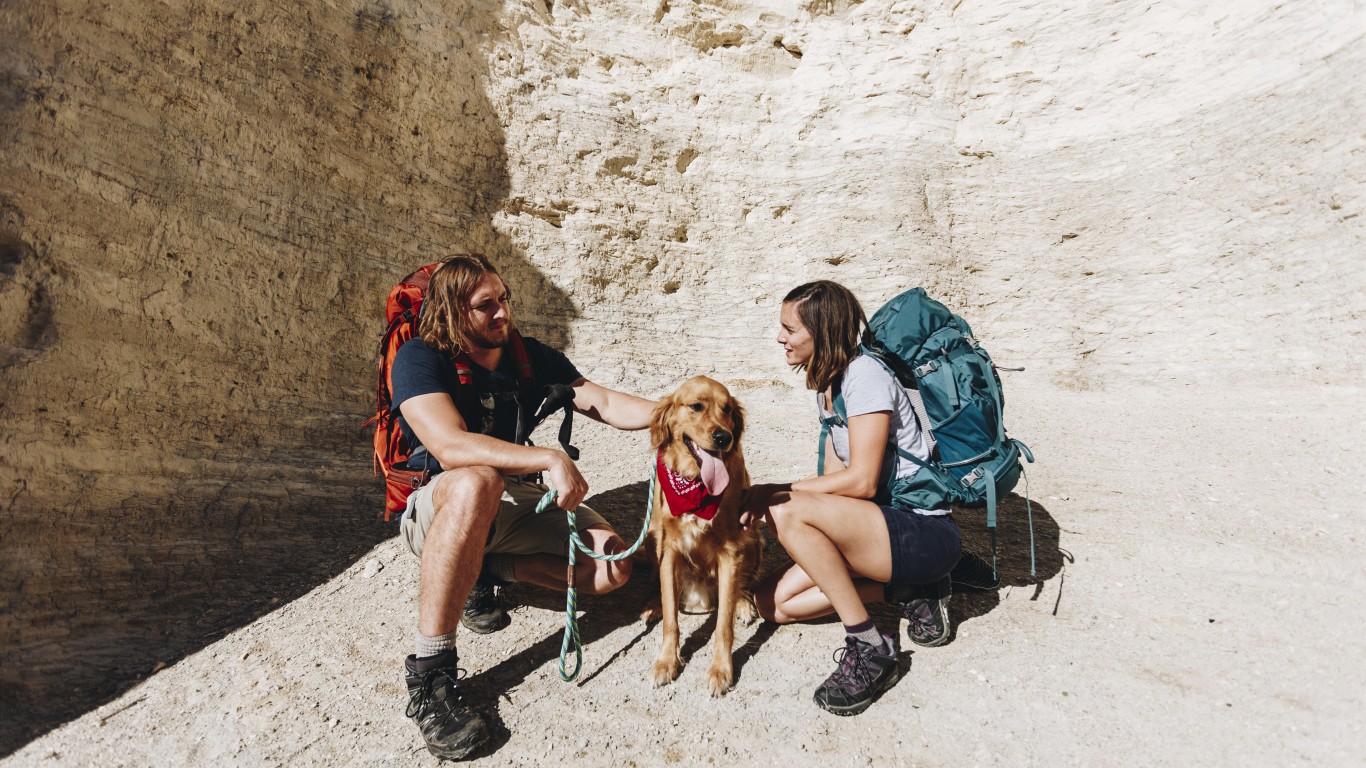
17. Kansas
> Households with at least one dog: 43.1%
> Number of dog-owning households: 490,000 — 16th lowest
> Number of human households: 1,136,000 — 16th lowest
> Dog population: 770,000 — 21st lowest

16. Texas
> Households with at least one dog: 43.4%
> Number of dog-owning households: 4,383,000 — 2nd highest
> Number of human households: 10,105,000 — 2nd highest
> Dog population: 7,570,000 — 2nd highest
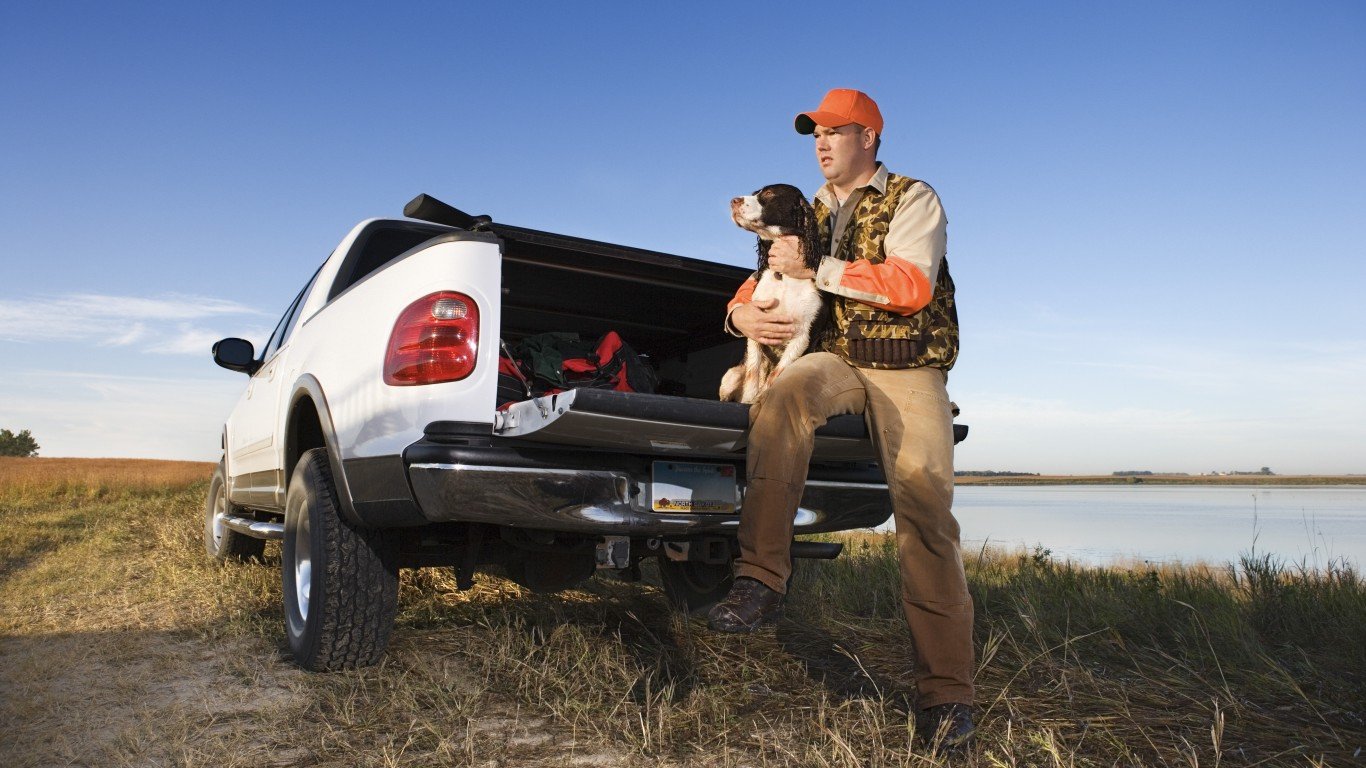
15. North Dakota
> Households with at least one dog: 44.3%
> Number of dog-owning households: 145,000 — 3rd lowest
> Number of human households: 328,000 — 3rd lowest
> Dog population: 213,000 — 9th lowest
[in-text-ad-2]
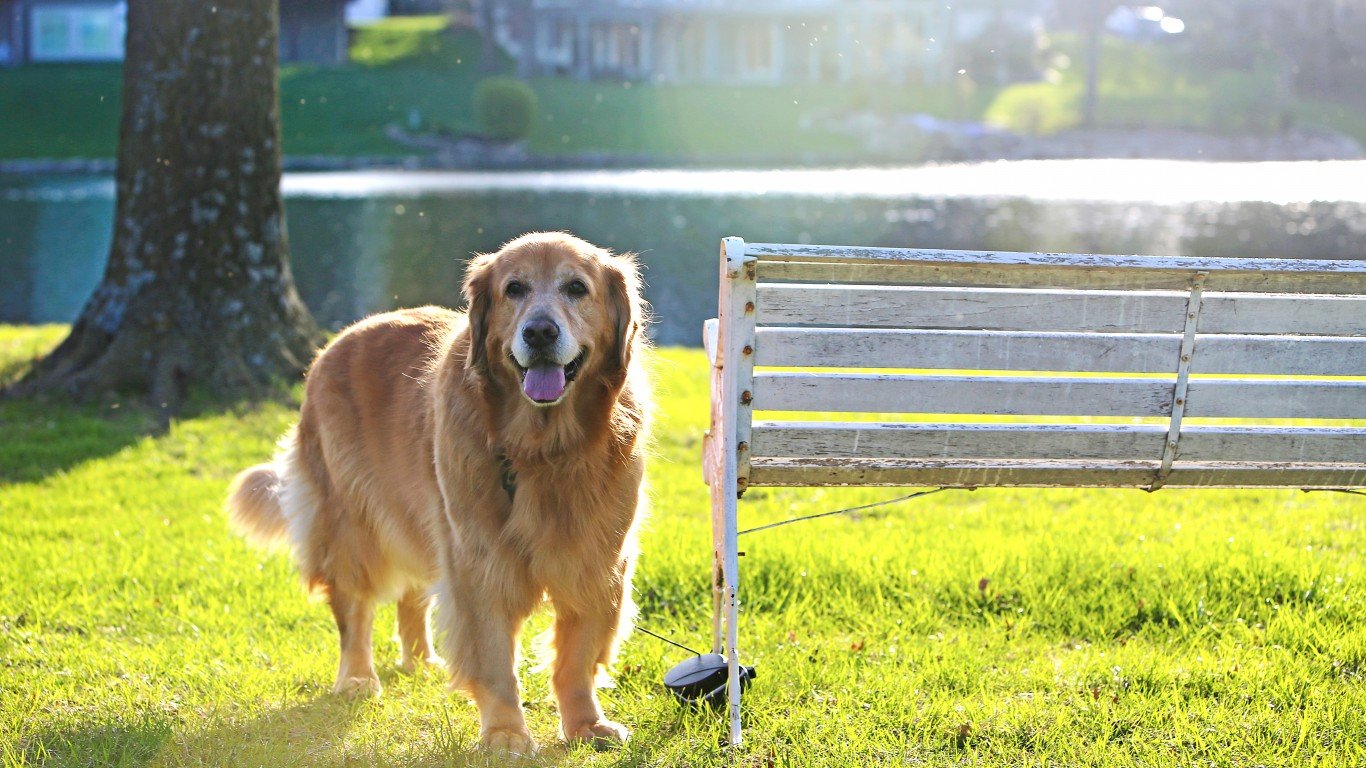
14. Missouri
> Households with at least one dog: 45.1%
> Number of dog-owning households: 1,090,000 — 18th highest
> Number of human households: 2,417,000 — 18th highest
> Dog population: 1,798,000 — 14th highest

13. South Carolina
> Households with at least one dog: 45.3%
> Number of dog-owning households: 907,000 — 23rd highest
> Number of human households: 2,002,000 — 23rd highest
> Dog population: 1,423,000 — 15th highest
[in-text-ad]

12. Kentucky
> Households with at least one dog: 46.5%
> Number of dog-owning households: 842,000 — 24th lowest
> Number of human households: 1,874,000 — 24th lowest
> Dog population: 545,000 — 17th lowest
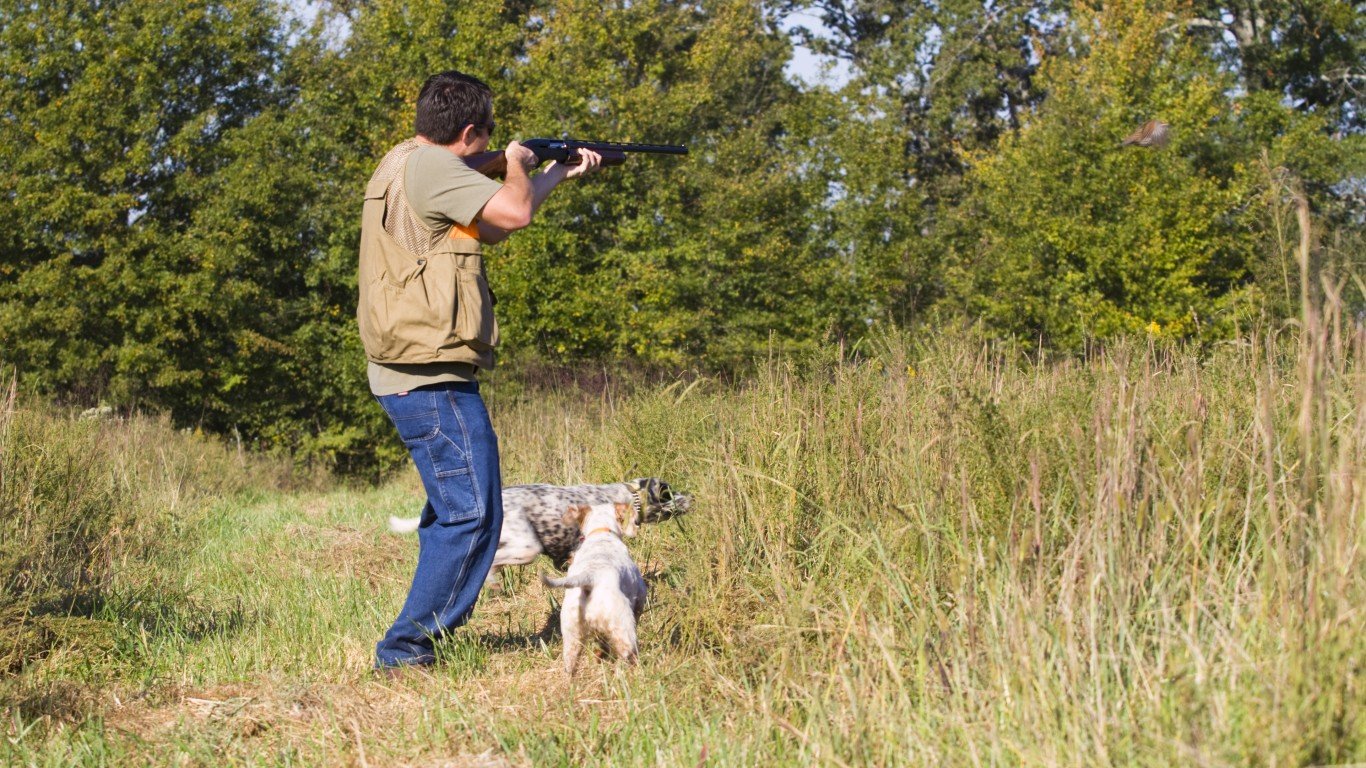
11. Alabama
> Households with at least one dog: 46.9%
> Number of dog-owning households: 931,000 — 24th highest
> Number of human households: 1,984,000 — 24th highest
> Dog population: 513,000 — 16th lowest

10. Tennessee
> Households with at least one dog: 47.0%
> Number of dog-owning households: 1,286,000 — 14th highest
> Number of human households: 2,736,000 — 14th highest
> Dog population: 799,000 — 22nd lowest
[in-text-ad-2]
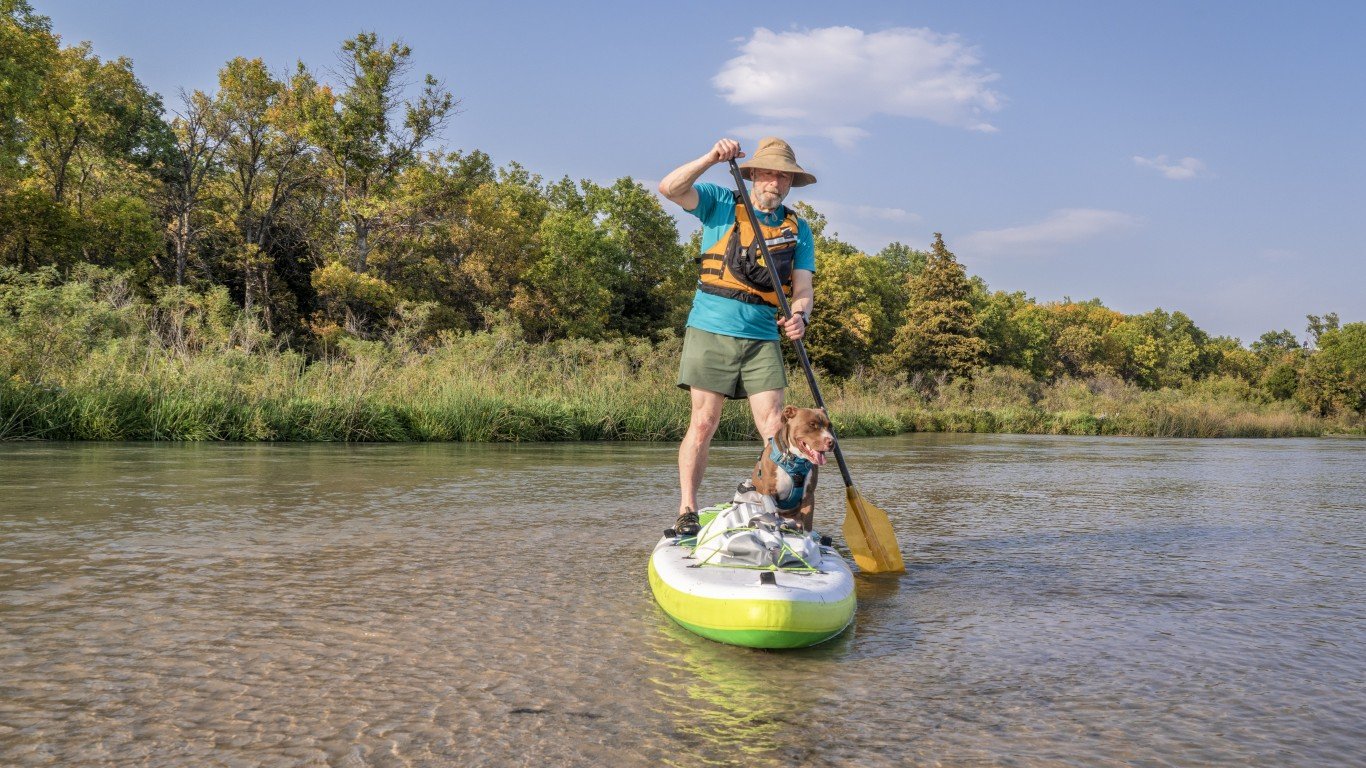
9. Nebraska
> Households with at least one dog: 47.1%
> Number of dog-owning households: 347,000 — 11th lowest
> Number of human households: 736,000 — 11th lowest
> Dog population: 634,000 — 18th lowest

8. Colorado
> Households with at least one dog: 47.2%
> Number of dog-owning households: 1,048,000 — 22nd highest
> Number of human households: 2,221,000 — 22nd highest
> Dog population: 671,000 — 20th lowest
[in-text-ad]
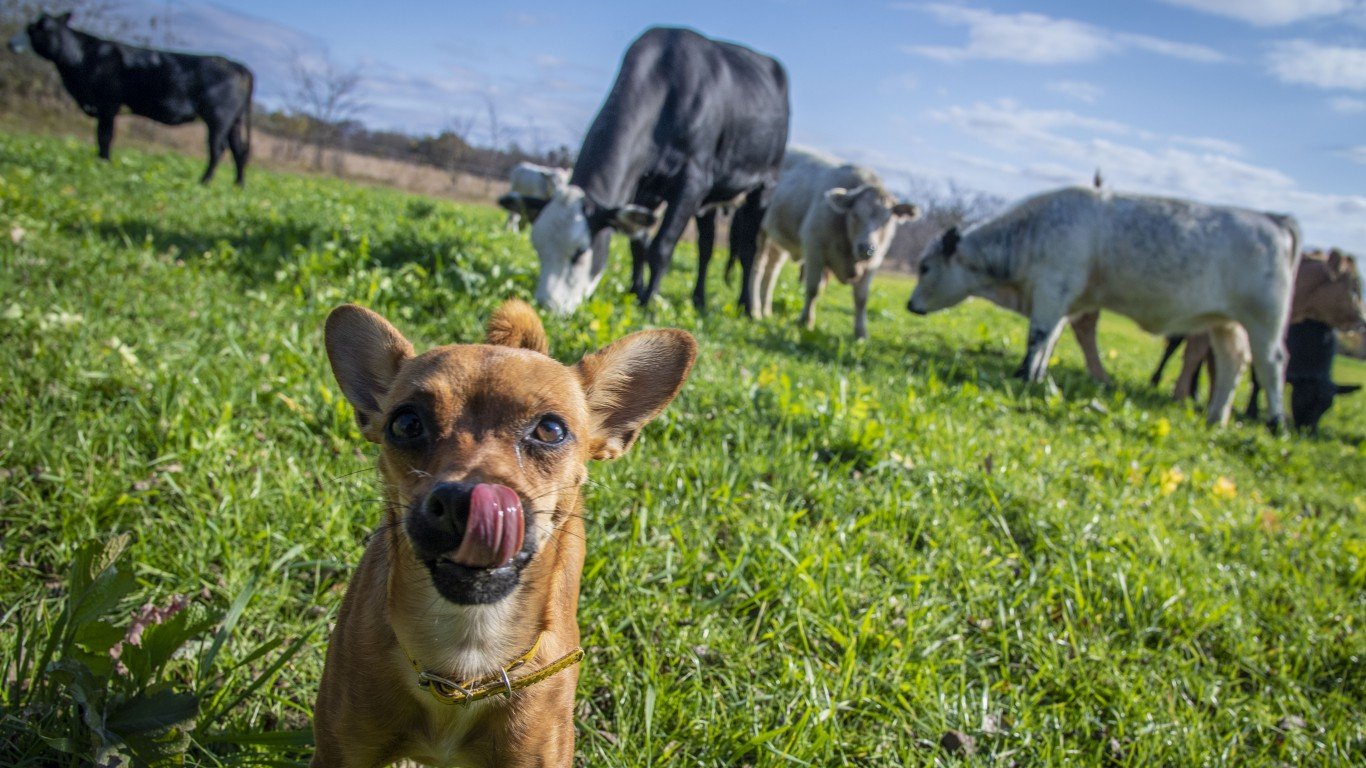
7. Oklahoma
> Households with at least one dog: 47.7%
> Number of dog-owning households: 757,000 — 21st lowest
> Number of human households: 1,587,000 — 21st lowest
> Dog population: 1,397,000 — 16th highest

6. Indiana
> Households with at least one dog: 49.4%
> Number of dog-owning households: 1,319,000 — 16th highest
> Number of human households: 2,670,000 — 16th highest
> Dog population: 2,142,000 — 11th highest

5. West Virginia
> Households with at least one dog: 49.6%
> Number of dog-owning households: 374,000 — 12th lowest
> Number of human households: 755,000 — 12th lowest
> Dog population: 637,000 — 19th lowest
[in-text-ad-2]

4. Mississippi
> Households with at least one dog: 51.0%
> Number of dog-owning households: 588,000 — 17th lowest
> Number of human households: 1,153,000 — 17th lowest
> Dog population: 276,000 — 10th lowest

3. Arkansas
> Households with at least one dog: 51.6%
> Number of dog-owning households: 625,000 — 18th lowest
> Number of human households: 1,211,000 — 18th lowest
> Dog population: 1,103,000 — 19th highest
[in-text-ad]

2. Montana
> Households with at least one dog: 51.9%
> Number of dog-owning households: 226,000 — 6th lowest
> Number of human households: 435,000 — 6th lowest
> Dog population: 112,000 — 3rd lowest

1. Idaho
> Households with at least one dog: 58.3%
> Number of dog-owning households: 378,000 — 10th lowest
> Number of human households: 648,000 — 10th lowest
> Dog population: 173,000 — 7th lowest
Sponsored: Find a Qualified Financial Advisor
Finding a qualified financial advisor doesn’t have to be hard. SmartAsset’s free tool matches you with up to 3 fiduciary financial advisors in your area in 5 minutes. Each advisor has been vetted by SmartAsset and is held to a fiduciary standard to act in your best interests. If you’re ready to be matched with local advisors that can help you achieve your financial goals, get started now.
Thank you for reading! Have some feedback for us?
Contact the 24/7 Wall St. editorial team.

 24/7 Wall St.
24/7 Wall St. 24/7 Wall St.
24/7 Wall St.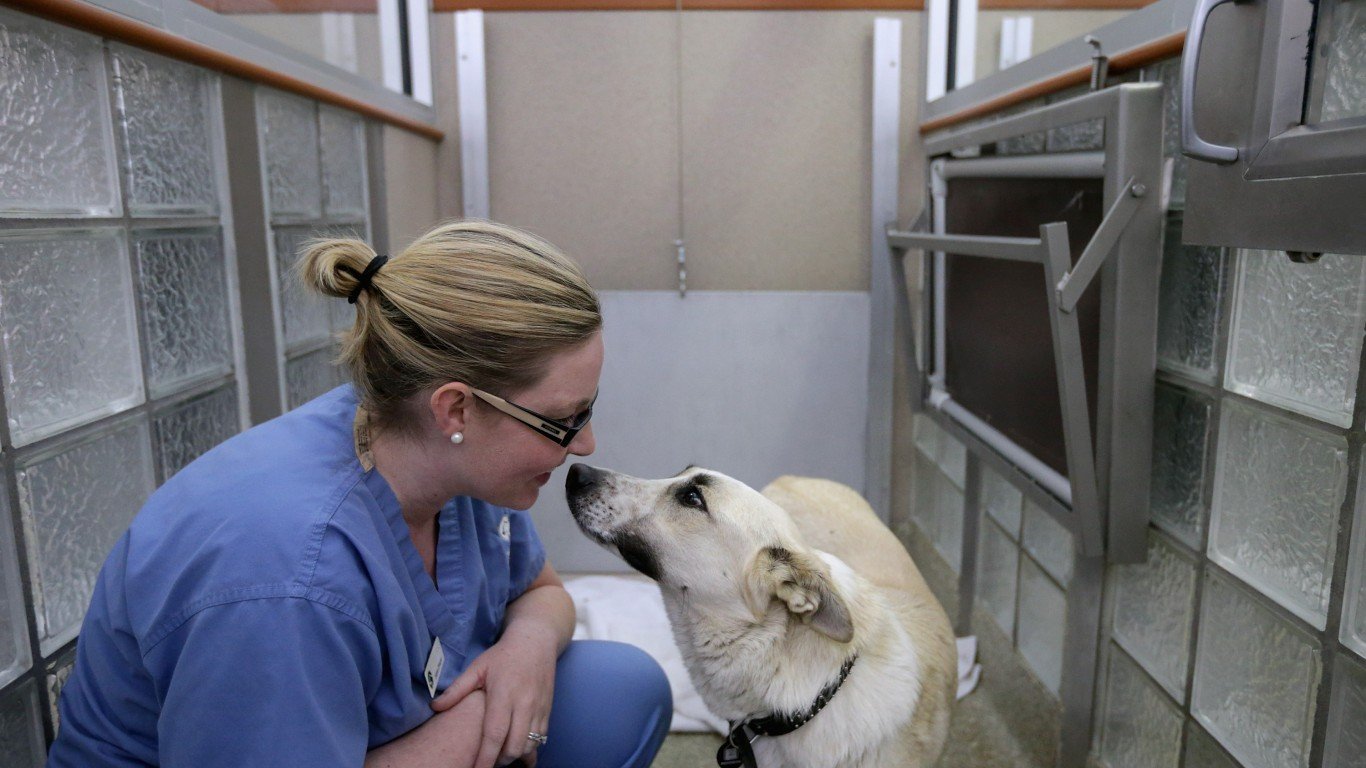 24/7 Wall St.
24/7 Wall St.

 24/7 Wall St.
24/7 Wall St. 24/7 Wall St.
24/7 Wall St.


